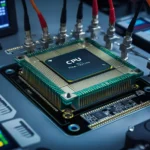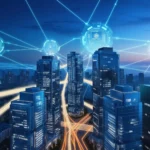Artificial Intelligence (AI) has leaped from the pages of science fiction into the fabric of our everyday reality. It’s not just a buzzword anymore – it’s the invisible force driving innovation and reshaping our world! Did you know that AI is already powering automation and data analysis in ways we interact with daily? From the moment we wake up to when we lay our heads down at night, AI is there, often working behind the scenes to make our lives easier, more efficient, and increasingly connected.
In this article, we’ll dive into the fascinating world of AI applications that are currently revolutionizing our routines and peek into the crystal ball to see what the future holds. Get ready to be amazed by the AI revolution happening right under our noses!
Current Applications of AI in Everyday Life
Smart Assistants and Virtual Helpers
One of the most visible and interactive forms of AI in our daily lives comes in the form of smart assistants and virtual helpers. These AI-powered companions have become an integral part of many households and workplaces, offering a wide range of services at the sound of our voice or the tap of a button.
Popular examples of these AI assistants include:
- Siri: Apple’s virtual assistant, known for its witty responses and integration with iOS devices.
- Alexa: Amazon’s AI helper, which powers the Echo line of smart speakers and other devices.
- Google Assistant: Google’s AI-powered assistant, available on Android devices and Google Home products.
These smart assistants are constantly evolving, learning from our interactions to better understand and anticipate our needs. They can perform a variety of tasks, such as:
- Setting reminders and alarms
- Answering questions and providing information
- Controlling smart home devices
- Playing music and podcasts
- Making phone calls and sending messages
The integration of these AI assistants with smart home devices has led to enhanced living experiences. Imagine walking into your home and saying, “Alexa, I’m home,” triggering a series of actions: lights turn on, your favorite playlist starts playing, and the thermostat adjusts to your preferred temperature. This level of automation and personalization is made possible by the seamless interaction between AI assistants and Internet of Things (IoT) devices.
As natural language processing (NLP) technology continues to improve, these virtual helpers are becoming more conversational and capable of understanding context and nuance in our requests. The future of smart assistants lies in their ability to proactively assist us, anticipating our needs before we even voice them.
Personalized Recommendations
AI has revolutionized the way we consume content and make purchasing decisions through personalized recommendations. Machine learning algorithms analyze our behavior, preferences, and past interactions to offer tailored suggestions across various platforms.
Streaming Platforms Services like Netflix, Spotify, and YouTube use AI to curate content based on our viewing or listening history. These platforms employ sophisticated recommendation systems that consider factors such as:
- Genre preferences
- Viewing/listening times
- User ratings and reviews
- Similar users’ behavior
The result? A personalized entertainment experience that keeps us engaged and discovering new content we’re likely to enjoy.
E-commerce Online shopping has been transformed by AI-powered recommendation engines. When you browse products on Amazon or other e-commerce sites, you’ll often see sections like “Customers who bought this item also bought” or “Recommended for you.” These suggestions are generated by AI algorithms that analyze your browsing history, purchase patterns, and similarities with other users.
These personalized recommendations not only enhance the shopping experience but also drive sales for businesses. According to a study by McKinsey, 35% of Amazon’s revenue is generated by its recommendation engine.
Social Media and News Feeds AI plays a crucial role in curating the content we see on social media platforms and news aggregators. Algorithms analyze our interactions, the content we engage with, and our connections to create a personalized feed. While this personalization can enhance our user experience, it has also raised concerns about filter bubbles and echo chambers, where users are primarily exposed to information that aligns with their existing beliefs.
As AI continues to evolve, we can expect even more sophisticated and accurate personalization across all aspects of our digital lives. The challenge will be striking a balance between personalization and diversity of content to ensure a well-rounded user experience.
Transportation and Navigation
AI has made significant inroads in the transportation sector, transforming how we navigate our cities and plan our journeys.
Ride-sharing Apps and Route Optimization Companies like Uber and Lyft rely heavily on AI to optimize their services. These apps use machine learning algorithms to:
- Predict demand in specific areas
- Optimize driver routes for efficiency
- Estimate arrival times accurately
- Dynamically adjust pricing based on demand (surge pricing)
The result is a more efficient transportation system that benefits both riders and drivers. AI-powered route optimization not only saves time but also reduces fuel consumption and emissions, contributing to more sustainable urban mobility.
Self-driving Car Technologies While fully autonomous vehicles are not yet commonplace on our roads, the technology is advancing rapidly. Companies like Tesla, Waymo, and traditional automakers are investing heavily in self-driving technology. Current applications include:
- Advanced driver-assistance systems (ADAS)
- Autopilot features for highway driving
- Self-parking capabilities
These technologies rely on a combination of AI, computer vision, and sensor fusion to perceive the environment and make split-second decisions. As the technology matures, we can expect to see more autonomous vehicles on our roads, potentially revolutionizing transportation and urban planning.
AI in Traffic Management Cities around the world are leveraging AI to improve traffic flow and reduce congestion. AI-powered traffic management systems use data from various sources, including:
- Traffic cameras
- GPS data from vehicles
- Sensors embedded in roads
These systems can adjust traffic light timings in real-time, predict congestion hotspots, and suggest alternative routes to drivers. For example, Pittsburgh’s Surtrac system, which uses AI to optimize traffic lights, has reduced travel times by 25% and wait times at intersections by 40%.As smart city initiatives gain momentum, we can expect to see more integration of AI in urban transportation systems, leading to smoother traffic flow and improved quality of life for city dwellers.
Healthcare and Wellness
The integration of AI in healthcare is one of the most promising and impactful applications of this technology. From diagnosis to treatment, AI is transforming various aspects of healthcare delivery and personal wellness.
AI-powered Diagnostic Tools Machine learning algorithms are being used to analyze medical images, such as X-rays, MRIs, and CT scans, with remarkable accuracy. In some cases, AI systems have demonstrated the ability to detect diseases like cancer at an earlier stage than human radiologists. For example:
- Google’s DeepMind AI can detect breast cancer in mammograms with an accuracy comparable to human experts.
- Stanford researchers developed an AI model that can identify skin cancer as accurately as dermatologists.
These AI-powered diagnostic tools are not meant to replace human doctors but to augment their capabilities, helping them make more accurate and timely diagnoses.
Personalized Treatment Plans AI is enabling the development of personalized treatment plans based on a patient’s genetic makeup, lifestyle, and other individual factors. This approach, known as precision medicine, aims to tailor treatments to each patient’s unique characteristics. AI algorithms can:
- Analyze vast amounts of medical data to identify patterns
- Predict how a patient might respond to different treatments
- Suggest optimal drug dosages based on individual patient data
In the field of oncology, for instance, IBM’s Watson for Oncology uses AI to analyze a patient’s medical information and provide evidence-based treatment options to oncologists.
Drug Discovery AI is accelerating the drug discovery process, which traditionally takes years and billions of dollars. Machine learning models can:
- Predict how different molecules will behave in the body
- Identify potential drug candidates from vast libraries of compounds
- Optimize drug formulations for better efficacy
Companies like Atomwise and Insilico Medicine are using AI to discover new drugs and repurpose existing ones for new treatments, potentially bringing life-saving medications to market faster and at lower costs.
Wearable Devices and Health Monitoring AI-powered wearable devices are empowering individuals to take control of their health. Smartwatches and fitness trackers use AI algorithms to:
- Monitor heart rate and detect irregularities
- Track sleep patterns and provide recommendations for better sleep
- Analyze physical activity and suggest personalized fitness plans
Some advanced wearables can even detect falls or predict the onset of conditions like atrial fibrillation. As these devices become more sophisticated, they have the potential to serve as early warning systems for various health issues, enabling proactive healthcare interventions.
The integration of AI in healthcare holds immense promise for improving patient outcomes, reducing healthcare costs, and making quality healthcare more accessible to people around the world.
Financial Services
The financial sector has been quick to adopt AI technologies, leveraging them to enhance security, improve customer service, and offer personalized financial advice.
Fraud Detection and Prevention AI algorithms are at the forefront of the battle against financial fraud. These systems can analyze vast amounts of transaction data in real-time to identify suspicious patterns and anomalies. Some key applications include:
- Credit card fraud detection
- Anti-money laundering (AML) systems
- Identity theft prevention
Machine learning models can adapt to new fraud techniques as they emerge, making them more effective than traditional rule-based systems. For instance, Mastercard’s Decision Intelligence uses AI to score transactions for the likelihood of fraud, reducing false declines by 50% while increasing fraud detection.
Robo-advisors AI-powered robo-advisors are democratizing access to personalized investment advice. These platforms use algorithms to:
- Assess an investor’s risk tolerance and financial goals
- Create and manage diversified investment portfolios
- Automatically rebalance portfolios based on market conditions
Robo-advisors like Betterment and Wealthfront have gained popularity, especially among younger investors, due to their low fees and ease of use. As these systems become more sophisticated, they may offer increasingly complex financial planning services traditionally provided by human advisors.
AI-powered Chatbots in Banking Many banks and financial institutions have deployed AI chatbots to handle customer inquiries and provide 24/7 support. These chatbots can:
- Answer frequently asked questions
- Assist with account management tasks
- Provide basic financial advice
For example, Bank of America’s virtual assistant, Erica, can help customers with various tasks, from checking account balances to scheduling bill payments. As natural language processing technology improves, these chatbots are becoming more conversational and capable of handling complex queries.
The integration of AI in financial services is not only improving efficiency and security but also making financial products and services more accessible to a broader range of consumers.
The Future of AI: Emerging Trends and Possibilities
As we look towards the future, the potential applications of AI seem boundless. Here are some emerging trends and possibilities that could shape our world in the coming years:
Autonomous Machinery and Robotics
The development of autonomous machinery and advanced robotics is set to transform various industries and aspects of our daily lives.
Widespread Adoption of Autonomous Vehicles While we’ve already discussed the current state of self-driving car technologies, the future promises even more widespread adoption of autonomous vehicles. This could include:
- Self-driving taxis and ride-sharing services
- Autonomous delivery vehicles and drones
- Self-piloting aircraft for passenger transport
The implications of this shift are profound, potentially reducing traffic accidents, easing urban congestion, and changing the very nature of car ownership.
Advancements in Industrial Robotics AI-powered robots are becoming increasingly sophisticated and capable of performing complex tasks in manufacturing and other industries. Future developments may include:
- Collaborative robots (cobots) that work alongside humans safely
- AI-driven quality control systems in production lines
- Autonomous robots for hazardous environments (e.g., disaster response, deep-sea exploration)
These advancements could lead to increased productivity, improved worker safety, and the ability to tackle tasks that are currently too dangerous or difficult for humans.
Impact on Industries and Job Markets The rise of autonomous machinery and robotics will undoubtedly have a significant impact on various industries and job markets. While some jobs may be automated, new roles are likely to emerge:
- AI trainers and ethicists
- Robot maintenance and programming specialists
- Human-AI collaboration facilitators
The key challenge will be managing this transition to ensure that the benefits of automation are distributed equitably and that workers have opportunities to reskill and adapt to the changing job market.
Enhanced Personalization
AI will enable unprecedented levels of personalization across various aspects of our lives.
Hyper-personalized Products and Services AI algorithms will analyze vast amounts of data to create products and services tailored to individual preferences and needs. This could include:
- Customized nutritional plans based on genetic data and lifestyle factors
- Personalized fashion items designed by AI based on individual style preferences
- Tailored travel experiences that cater to specific interests and preferences
Adaptive Learning and Education AI will revolutionize education by enabling truly personalized learning experiences:
- Adaptive learning systems that adjust difficulty and pacing based on student performance
- AI tutors that provide one-on-one assistance and answer questions in real-time
- Personalized curriculum design that caters to individual learning styles and interests
These advancements could make education more effective, engaging, and accessible to learners of all ages and backgrounds.
Customized Entertainment and Content Creation AI will play an increasingly significant role in creating and curating entertainment content:
- AI-generated music tailored to individual tastes
- Personalized video game experiences that adapt to player behavior
- AI-written stories and scripts based on user preferences
While this level of personalization offers exciting possibilities, it also raises questions about the future of human creativity and the potential for AI to influence our cultural experiences.
AI in the Workplace
The integration of AI in the workplace will continue to evolve, changing the nature of work itself.
Transformation of Job Roles As AI takes over routine and repetitive tasks, human workers will likely focus more on roles that require creativity, emotional intelligence, and complex problem-solving. This shift may lead to:
- Increased emphasis on soft skills in the workplace
- New job categories that focus on human-AI collaboration
- Continuous learning and upskilling becoming the norm
AI-augmented Decision-making AI will increasingly support human decision-making in various fields:
- Business strategy informed by AI-powered market analysis
- Medical diagnoses supported by AI analysis of patient data
- Legal research and case preparation assisted by AI
The goal is not to replace human judgment but to enhance it with data-driven insights and pattern recognition capabilities that AI excels at.
Increased Productivity and Efficiency AI-powered tools and automation will continue to boost productivity across industries:
- Intelligent project management systems that optimize resource allocation
- AI-driven process optimization in manufacturing and logistics
- Automated report generation and data analysis in various fields
These advancements could lead to shorter work weeks and more time for creative and strategic tasks, potentially improving work-life balance for many employees.
Ethical Considerations and Challenges
As AI becomes more pervasive in our lives, it brings with it a host of ethical considerations and challenges that society must grapple with.
Privacy Concerns and Data Protection The effectiveness of AI systems often relies on vast amounts of data, raising concerns about privacy and data protection:
- How can we ensure the responsible collection and use of personal data?
- What rights should individuals have over their data used in AI systems?
- How can we prevent the misuse of AI-generated insights?
Addressing these concerns will require a combination of robust legislation, ethical AI development practices, and public awareness.
Addressing Bias in AI Algorithms AI systems can inadvertently perpetuate or amplify existing biases present in their training data or design:
- How can we ensure fairness and prevent discrimination in AI-driven decision-making?
- What steps can be taken to diversify AI development teams and datasets?
- How can we make AI systems more transparent and accountable?
Efforts to address these issues include developing fairness-aware machine learning algorithms and establishing ethical guidelines for AI development.
Impact on Human Creativity and Free Will As AI systems become more capable of generating creative content and making decisions, questions arise about the role of human creativity and agency:
- How will AI-generated art and content affect human creativity and cultural expression?
- What are the implications of relying on AI for decision-making in personal and professional contexts?
- How can we maintain human autonomy in an increasingly AI-driven world?
These philosophical and ethical questions will likely become more pressing as AI capabilities continue to advance.
AI and Sustainability
AI has the potential to play a crucial role in addressing global sustainability challenges.
Climate Change Mitigation AI can contribute to climate change mitigation efforts in various ways:
- Optimizing energy grids for increased renewable energy integration
- Improving climate models for more accurate predictions and planning
- Enhancing the efficiency of carbon capture and storage technologies
Smart Energy Management AI-powered systems can significantly improve energy efficiency:
- Smart building management systems that optimize heating, cooling, and lighting
- Intelligent traffic management to reduce congestion and emissions in cities
- AI-driven demand response systems for more efficient electricity distribution
Resource Optimization AI can help optimize the use of natural resources:
- Precision agriculture techniques that reduce water and fertilizer use
- AI-powered recycling systems that improve waste sorting and processing
- Predictive maintenance in industry to reduce resource waste and extend equipment life
The application of AI in sustainability efforts holds promise for creating a more environmentally friendly and resource-efficient future.
Conclusion
As we’ve explored, AI is no longer a distant dream – it’s a powerful force shaping our present and future. From the smart assistants that manage our daily tasks to the autonomous machinery on the horizon, artificial intelligence is revolutionizing every aspect of our lives. The applications we’ve discussed – from personalized recommendations and healthcare diagnostics to financial services and sustainability efforts – are just the tip of the iceberg.
The future of AI promises even more exciting possibilities. We’re looking at a world where hyper-personalization becomes the norm, where education is tailored to each individual’s learning style, and where AI augments human decision-making in complex fields like medicine and law. Autonomous vehicles and advanced robotics could reshape our cities and workplaces, while AI-driven solutions tackle some of our most pressing global challenges, including climate change and resource management.
However, as we stand on the brink of this AI-powered future, it’s crucial to approach it with both optimism and caution. The ethical considerations we’ve discussed – privacy concerns, algorithmic bias, and the impact on human creativity and free will – are not just philosophical debates but pressing issues that need to be addressed as we continue to integrate AI into our everyday experiences.
The key to harnessing the full potential of AI responsibly lies in collaboration between technologists, policymakers, ethicists, and the public. We need to:
- Develop robust regulatory frameworks that protect individual privacy and ensure the ethical use of AI.
- Invest in AI literacy programs to help the public understand and engage with these technologies.
- Encourage diverse representation in AI development to mitigate bias and ensure AI systems serve all segments of society.
- Foster interdisciplinary research to explore the societal impacts of AI and develop best practices for its implementation.
As we continue to push the boundaries of what’s possible with AI, we must also remain vigilant in preserving the values that make us human – creativity, empathy, and free will. The future of AI is not about replacing human intelligence but augmenting it, creating a symbiotic relationship where humans and AI work together to solve complex problems and create new possibilities.
The AI revolution is happening now, and its impact will only grow in the coming years. It’s an exciting time to be alive, as we witness and participate in this technological transformation. The choices we make today in developing and deploying AI will shape the world of tomorrow.
So, are you ready to embrace the AI-powered world of tomorrow? Whether you’re a tech enthusiast, a cautious observer, or somewhere in between, there’s no denying that AI will play an increasingly significant role in our lives. By staying informed, engaging in discussions about the ethical use of AI, and being open to the possibilities it offers, we can all contribute to shaping a future where AI enhances human potential and improves lives across the globe.
As we step into this AI-driven future together, let’s approach it with curiosity, responsibility, and a commitment to harnessing this powerful technology for the greater good. The AI revolution is not just about smart gadgets and efficient algorithms – it’s about reimagining what’s possible and creating a world where technology and humanity coexist in harmony, pushing the boundaries of innovation while preserving the essence of what makes us human.
The future is here, and it’s powered by AI. Are you ready to be part of this extraordinary journey? Let’s embrace the challenges, seize the opportunities, and work together to create an AI-enhanced world that benefits us all. The possibilities are limitless – it’s up to us to shape them responsibly and ethically. Welcome to the age of AI – where every day brings new wonders and the potential to make our world a little bit better, one algorithm at a time!














